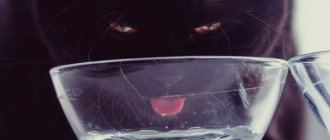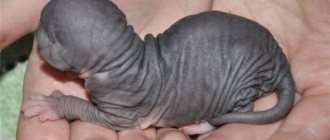The positive impact of pets on human daily activities cannot be overestimated. Pets give their owners many positive moments: they share joy with them, console them in moments of despair, save them from boredom, and even help them recover faster. But regarding personal life, not everything is so clear: American researchers have come to the conclusion that a person who has a pet may experience certain difficulties in relationships.
A little about physiology
Sex for love happens if animals roam freely on the street, practically homeless. Then cats engage in mating completely uncontrollably. Some owners “maintain the purity of blood” and agree that their prize-winner mates only with cats of the same breed. Sometimes the owners are not against “marriage” with any partner out of pity for the suffering pet, or because they can no longer bear to listen to the screams.
Photos. Adults only content
© shutterstock
[collapse]
Physiological and sexual maturity are not the same thing. The second comes much earlier. Males are capable of mating and impregnating female kitties by about eight months and almost to the point of death. Girls mature a little earlier, at 7 or 10 months, and are fertile until 8-9 years of age. The “festivities” continue year-round, lasting for the young ladies from 6 to 8 days and after three weeks they can come again. The time of the first "hunt" and frequency usually depend on the breed, for example, Siamese and Persians are more likely to do so than Scots.
Age can be a hindrance
Most cats begin to scream by 8 months, but it is better to wait until a year to mate. The situation is similar with cats; by about the age of one year they are ready for a relationship. It is not recommended to mate a cat earlier; her body may not yet be ready for such stress. Although it may be wrong to force a cat to mate at an older age (over 10 years), the risk of giving birth to sick kittens increases.
Do neutered cats want a cat?
During castration, the veterinarian removes both ovaries from the cat, and in addition to them, the uterus is often removed. In the vast majority of cases, this is guaranteed to relieve you of all problems associated with the cat’s sexual behavior: high-pitched meowing, rolling on the floor and other symptoms so familiar to all owners of adult cats. However, in a small percentage of cats, this behavior may occur again some time after neutering. What is this connected with?
SOY can be determined by the results of a hormone test, which is collected at a veterinary clinic. If the diagnosis is confirmed, then it is necessary to perform a second operation and remove the fragment of the ovary left in the animal’s body.
Most often, the reason for this can be the so-called abandoned ovary syndrome (OSS). During castration, the veterinarian may inadvertently remove not all the ovaries entirely, but leave part of one of them. In this case, the remaining tissue takes over the function of the whole ovary and produces sex hormones, which causes the castrated cat to ask for a male cat.
Sometimes veterinarians suggest that the cause of a cat’s sexual behavior after castration may be the pituitary gland or uterus, if the latter was not removed during surgery. This assumption is fundamentally incorrect. Neither the pituitary gland nor the uterus can provoke what the cat asks for the cat.
What does a cat's March look like?
Surprisingly, many people have never seen mating in cats..
Some people, seeing their pet screaming and rolling around, run to the veterinarian, thinking that the animal is in severe pain. Estrus is a physiological process that means animals are ready to reproduce. The need to procreate is so strong that the cat becomes simply mad and, without stopping, screams, calling for the cat. As a rule, domestic kitties roam at any time, but most intensely in February - March and at the end of summer.
© shutterstock
Girls
- genitals swell
- the cat licks itself more often
- eats poorly or refuses to eat.
- becomes more affectionate or aggressive
- constantly rubbing against everything
- squirms and rolls on the floor.
- trying to run away from home
- purrs or makes high-pitched, drawn-out sounds
- moves with half-bent hind legs
- moves the tail to the side.
Boys
A sexually mature healthy male is ready to mate at least eight times a year, almost always. If a cat is not allowed outside, then this period is very difficult for its owners, the pet becomes aggressive, tries to rape soft toys, screams and howls loudly all the time, scratches everything, leaves smelly marks all over the house.
Cats that can walk on their own usually disappear for a week or more, mate intensely, fight, and return hungry and injured after fights with other cats.
Terrible jealousy
Showing attention is pleasant for everyone: both humans and furry pets. So, if you have both a partner and a cute cat, both of them may feel jealous and fight for the right to top your list of priorities.
It is known that people can establish the same strong emotional connection with animals as with members of their own species. A pet's jealousy is especially pronounced if the owner has it before the owner entered into a close relationship with anyone. Now the owner has to be “divided”, the attention gets half as much, and there is little time for interaction.
This mainly applies to dogs, since they become much more attached to humans than, for example, cats. But there is a known case when a cat could not tolerate the sexual intimacy of its owner with his chosen one and desperately scratched at the door of the room behind which the loving couple was secluded. It would not be surprising if partners also felt great discomfort because of this, which, in turn, negatively affected the relationship.
Returning to the studies conducted in America, it is necessary to note the following: 40% of the subjects responded that they felt as if they were competing with a loved one’s pet.
Of this number, 22% of respondents said that they consider their partner’s attention to their pet excessive.
19% noted their chosen one’s strong attachment to their four-legged friend.
17% said they see their partner's strong love for the animal, but don't see the same love for themselves.
In addition, more than half of those surveyed said that they were ready to ask their lovers to give up their pet in order to preserve the relationship! However, such an idea would most likely be doomed to failure: 70% of pet owners would rather give up their partner than their beloved pet.
Do not miss
- Do not miss
What does jealousy lead to? Advice from a lawyer
First meeting
Once on someone else's territory, the groom will try to mark it, or he may become embarrassed and not show the proper ardor during mating, which is why the bride is usually brought to the cat.
For the cat, they take with them a “dowry” - its tray, bowl and familiar carrier, where it can hide and rest if necessary.
Of course, the bride should be well-groomed, but there is no need to bathe her before the meeting, this will take away the natural smell that attracts mating. The groom's owners are responsible for the safety of the bride and provide a place for marriage games.
Let's check your health
Before mating, partners are checked for diseases; it is advisable to give a drug against worms a couple of weeks before the wedding. Be sure to get the necessary vaccinations no later than a month before mating.
© shutterstock
Before the meeting, newlyweds should trim their nails so that they do not injure each other. To avoid injury, it is also not advisable to mate virgins - one of the animals must already be experienced.
Behind the bedroom doors
Often the cat herself begins to flirt, but when the cat tries to mate, she grins and hits with her paw. The cat has to accept her rules, he moves away and pretends that he doesn’t care. This can go on for hours, but as soon as the lady loses her vigilance, the cat bites her by the scruff of the neck and penetrates her. The mating itself is short-lived, about a minute, then the cat, as a rule, screams and throws the gentleman off her, rolls over on her back and rolls on the floor, and the winner moves aside and puts herself in order.
Pussies are capable of having sex for up to three days, it is not without reason that they say that when walking like a cat, a cat is capable of re-copulating with a cat almost every hour . Usually it is immediately clear that everything went well, the newlyweds no longer quarrel, they are affectionate, lie next to each other, lick each other. When one of the meeting participants loses interest in the process, it all ends. A cat usually gives birth on the 55-60th day after mating. If the cat goes into next heat, it means that pregnancy has not occurred; to avoid this, it is better to arrange a second meeting in advance.
Cat copulation with cat
Cats usually make love at night. Most people are familiar with the loud screaming that occurs during cat weddings, but some don't know what actually happens.
The cat calls the female with a loud meow, which is often called a cat concert. By doing this, he pursues two goals: advertising his capabilities and warning other cats about his intentions. The cat's interest in the cat increases when he hears her voice or smells her excrement. Usually the cat is the first to take the initiative: rubbing its head or nose against the cat or sniffing its genitals. The expression on a cat's face when he smells a cat during her heat is called a Flemen smile (the smell of a cat's pheromones irritates the cat's olfactory organs, which are located on the palate). The cat wrinkles its nose and a grin appears, vaguely reminiscent of a smile.
The cat emits a soft meow, which indicates its readiness for copulation, and begins to spin around the cat. If a cat is in the first stage of estrus, she does not accept courtship and does not allow herself to be “saddled”. But when she is ready, she accepts the cat's enlarged penis by pressing her hind legs to the ground and moving her tail to the side. The cat grabs her by the scruff of the neck with his teeth and climbs on top of her. He steps with his hind legs and pulls his penis back, which becomes hard. Then he begins to make movements that facilitate the penetration of the penis into the cat’s genital organ. For some time after the insertion of the penis, the cat remains motionless, at this moment the cat becomes excited, its pupils dilate. During ejaculation, semen is released into the vagina near the cervix.
After ejaculation, the cat pushes the cat off her, hits him with her paw with her claws extended and lets out a loud scream. The only explanation for this behavior of the cat is that when the penis is removed, the numerous keratinized spines located on it cause it severe pain. Of course, only she herself knows for sure about this, and she will never tell us about it. It is believed that the keratinized spines stimulate the release of an egg from the ovaries of a full-fledged cat.
In domestic cats, ovulation, or the process of releasing eggs from the ovaries, occurs when the hormone levels in their body are at their maximum. Rarely, in 50 cases out of 100, ovulation can occur after a single copulation. Usually, four copulations are enough for a cat to ovulate and become pregnant. But it won't be surprising if it takes ten or twelve to succeed.
Let's return to the act of copulation itself. The entire process - from courtship to sexual intercourse and ejaculation - lasts no more than 4 minutes. After removing the penis, the cat tries to dodge the blow of the cat's paw, moves aside with an indifferent look and begins to carefully lick its penis and paws. The cat also grooms itself and licks the external genitalia.
After 5 - 15 minutes, the cat is again ready for sexual intercourse. As the number of copulations increases, so does the length of time required for recovery: even a great lover of lovemaking has a limit. Sometimes, extremely rarely, a cat can offer herself first: at the same time, she shamelessly flirts with the cat, moves her back towards him, almost rests on his nose, purring, and rubs her head against his head.
Meanwhile, during copulation, other cats may be nearby, waiting for their turn, and the order is determined as a result of a fight. Typically, a cat will choose and mate with multiple males, so kittens from the same litter may end up with different fathers. But sometimes it happens that a cat chooses one partner with whom it has numerous acts of copulation.
It must be said that not all cats can copulate in the place you specifically choose. A shy cat may become frightened by all the fuss going on around them. Then you need to prepare her for this act: for several days, bring and leave the cat of your choice in the house so that the cat can get used to the environment and smells. It matters a lot how experienced the cat is. If the cat rejected it once, then offer it again.
By the way, what is considered sexual abuse is very rare among cats. Firstly, it is very difficult for a cat to penetrate a cat if she does not want it - she does not raise her butt and does not move her tail to the side. Secondly, rape is seen as an aggressive act, and cats copulate solely out of mutual interest in sex.
Deviations in the sexual behavior of cats and other animals can be observed when they find themselves in stressful situations. For example, it is known that rats usually adhere to strict protocol in sexual relations, but may resort to rape if forced to live in overcrowded conditions. Murders are common in these conditions. Catnip, which acts like a narcotic on some cats, can cause sexual aggression in cats.
The mating of a cat with a cat also has individual characteristics, which you can familiarize yourself with in a separate article.









